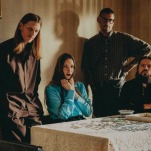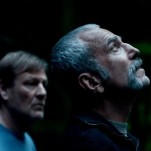Apple’s Spaceship Campus Will Lead to More Innovative Workplace Design
Photos courtesy of Apple, Getty/Justin Sullivan, The Farm Soho, The Labor Party & The Nebula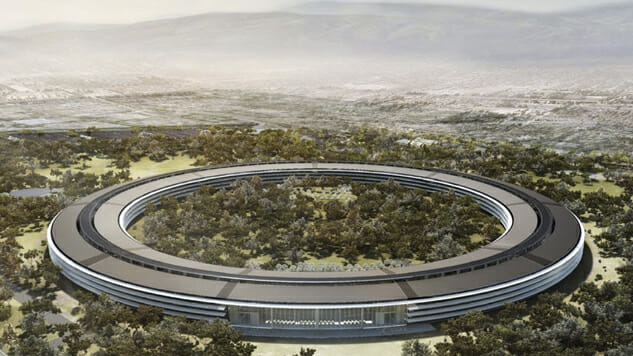
In just a short time, Apple will begin moving into its famed new “Spaceship” campus. Officially named Apple Park, the massive project is nearing completion after nearly six years of planning and building. $5 billion project, developed in collaboration with architects Foster + Partners, has been easy to follow for observers of the company with drones providing aerial footage of the construction on a regular basis. The dramatic shape of the building, a simple perfect circle, is a testament to Apple’s unique focus on design. But it also calls to mind a famous quote from Steve Job on his design philosophy:
“Most people make the mistake of thinking design is what it looks like. People think it’s this veneer – that the designers are handed this box and told, ‘Make it look good!’ That’s not what we think design is. It’s not just what it looks like and feels like. Design is how it works.”
If design is “how it works,” what does that mean for Apple’s new campus? More importantly, what does that mean for the role of design in workspaces overall? Does the look and feel of an office change it’s functionality? Are beautiful workplaces more likely to inspire creativity, or are they simply distracting? If employees feel relaxed in an office, will this make them more productive, or will it simply make them bored?
Architects and planners like those at Foster + Partners have pondered these questions for years. A most popular concept in workplaces is the open-space design. These large open seating areas are thought to inspire collaboration between team members.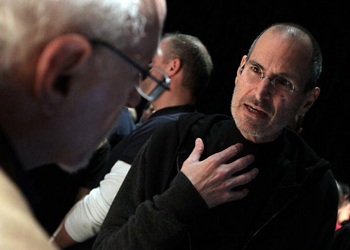
“Steve’s vision for Apple stretched far beyond his time with us. He intended Apple Park to be the home of innovation for generations to come,” said Tim Cook, Apple’s CEO. “The workspaces and parklands are designed to inspire our team as well as benefit the environment. We’ve achieved one of the most energy-efficient buildings in the world and the campus will run entirely on renewable energy.” The building features the world’s largest panels of curved glass. And Apple Park will also include a visitors center with an Apple Store® and cafe open to the public and a 100,000-square-foot fitness center for employees.
Apple Park was always going to reflect the company’s intensive focus on design. Rumors swirling around the massive undertaking suggest executives paid attention to every detail of construction, from the look of signage in the building to the invention of an iPhone-inspired toilet. Despite sharing regular construction updates online, Apple is one of the most secretive companies on Earth. The interior design remains an opaque mystery. But one thing is clear: the new Apple Park is designed to inspire a feeling of openness and connection to the natural environment in which its located.
Here are three ways corporations can leverage thoughtful design to make their workplaces more innovative.
Create More Urban Workspaces
In the past, there was a tendency to make every workspace feel like it was in a distant part of the office, unconnected to the urban fabric of the city it’s located in. Offices featured drab, cookie cutter cubicles that could be found in any city in the world. This was true for offices in downtown towers or low rise buildings on the outskirts of cities.
Now, large companies are just as likely to build offices that feel more like an artist’s loft than a traditional workplace. 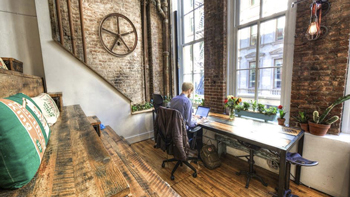 There has been a resurgence in urban centers over the last 20 years and companies large and small want to connect to that trend.
There has been a resurgence in urban centers over the last 20 years and companies large and small want to connect to that trend.
While it has been common for a while now for small companies and startups to work in repurposed warehouses or lofts, that trend is now catching in with large corporations as well. This is part of a larger trend of companies looking to get connected with startup culture and the innovation surrounding it.
Integrate Local Design Elements
Every city has its own unique visual style and colors. San Francisco is known for its Victorian houses; New York has it bright yellow cabs and glass skyscrapers; London is a red town down to the Tube signs, buses, and phone booths; and Tel Aviv is the White City with its Bauhaus architecture.
Employees want to feel connected to the city in which they live. That feeling should continue in their workplace as well. It helps employees feel comfortable and at home in their office since they don’t feel like they are trapped in a foreign bubble. Bringing local design elements into a workplace is a great way to foster a sense of community, and to tie that feeling into the company that people work for. In addition, it opens opportunities to connect with local artists and designers, further building a presence amongst the wider community.
Design For Your Brand
Innovation can be a demanding task, requiring both high levels of creativity and energy from employees. It also demands a strong identification and affinity for the company people are working for. Engendering that kind of feeling amongst employees demands a strong brand identity that permeates every part of a company – including the workspace itself.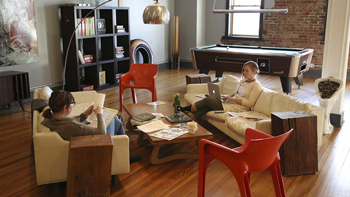
In that way, companies are infusing their brand into workspaces and are also allowing beautifully designed workplaces to reinvigorate their brand identity. What’s surprising is that many large companies with well established brand identities are looking to many of the strategies listed previously to bring their brand identity back into their workplaces. On top of this, some large corporations are looking to open new locations near or alongside young companies and startups in developing urban centers and even in coworking spaces.
Design can help your workspace achieve multiple objectives beyond just providing employees with a comfortable work environment. For a company that is looking to drive innovation and growth, sending a clear message to employees through their work environment can have a profound impact. What should that message be? That depends on the company. But knowing that your company is open to new ideas and creative thinking just by looking at the office space around you can help inspire those same qualities in the people who work there.
Dan Zakai is the Co-founder and CEO of Mindspace, a global provider of coworking spaces which keeps companies inspired through its authentic community services, vintage decor and boutique experience for teams of all sizes, from freelancers to major companies like Volkswagen.

